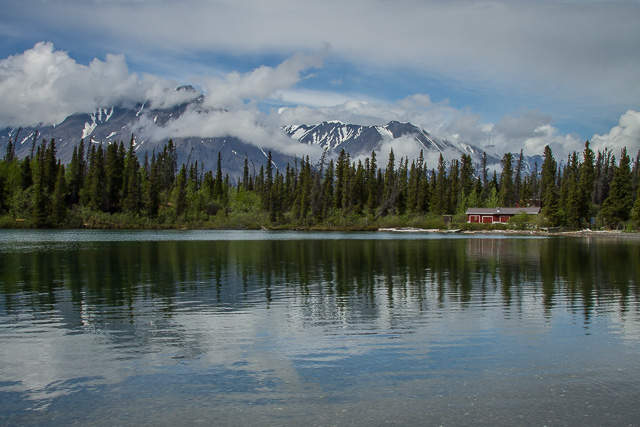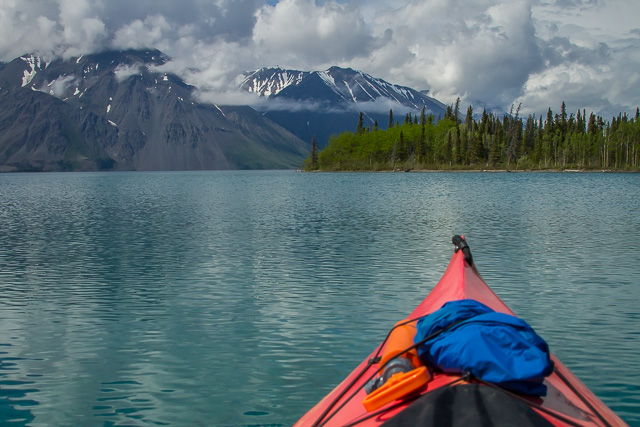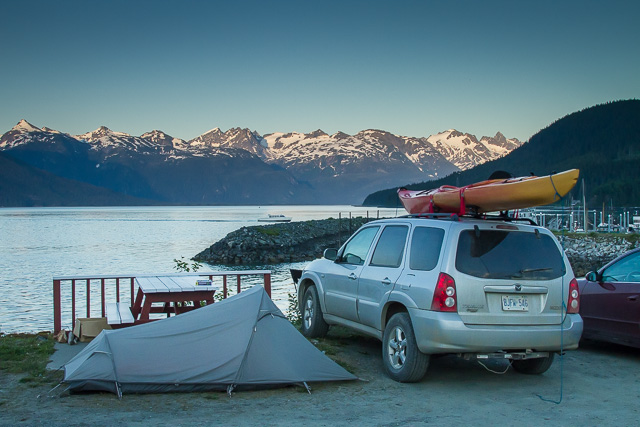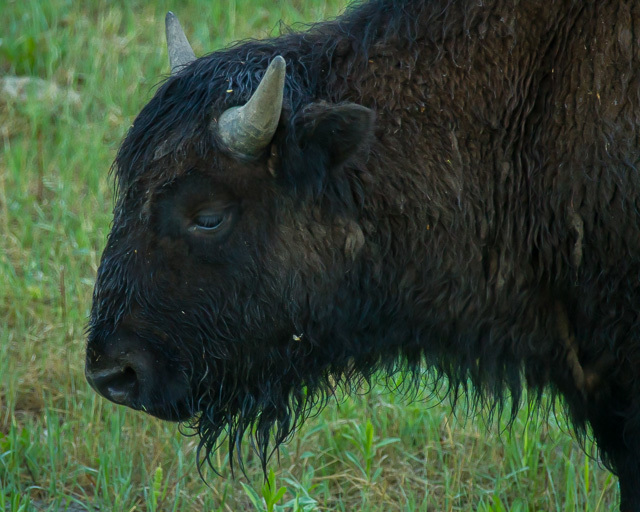Yukon Trip - Days 15-21: Finally a Grizzly!
/June 9, 2013 - Day 15
With my vehicle disabled at the repair shop across the road, I arose from my slumber at Bonanza Gold Hotel in Dawson City, Yukon at 8:00 AM. I was thankful not to have slept beside the Dempster Highway the night before but I still had worries. Most notably, when would my car get fixed?
With a slim hope that my car could get repaired on a Sunday, I called Doug the tow truck driver. My hope was quickly dashed. Doug told me to call Ken at NAPA at 8:00 AM on Monday morning. So there it was. I was in the Yukon without a functioning car and with no idea when it would be repaired. Ah, well. Not to worry. I switched to a cheaper room at the hotel, ate some lunch and decided to explore my surroundings.
I walked 2 km into Dawson and looked for ways to pass the time. With its wooden sidewalks, it was neat to think about the oldtimers during the gold rush walking on the same spots. I saw a sign for a show that night at Diamond Tooth Gertie's, the local casino. I returned to the hotel, did some laundry, and ate a dinner of canned tuna with jalapenos, canned peaches, and apple sauce. Such is the life of a frugal traveller that shuns a cooler.
A helpful and pleasant lady working at the hotel offered to drive me into town that evening to save me from walking there again. It never hurts to mention that you have a broken-down car when you need help from strangers! I gladly accepted the offer and got to the casino early enough to play some $5 per hand blackjack and enjoy two very good shows, each with charismatic singing and cancan dancing ladies. The later show got more risqué and I wanted to stay for the third show at midnight which apparently takes the risqué to a whole other level. However, even though it was still light out at 11:00 PM, I wasn't looking forward to walking 2 km back to the hotel well past midnight so I left after the second show, hopeful to hear good news about my car the next day.
June 10, 2013 - Day 16
I called NAPA to ask about my car. They regrettably informed me that there were no tires in the city that fit my car - they would have to be ordered from Whitehorse. My best hope was that they were delivered the following day. There was nothing I could do but continue to wait.
I walked around town for much of the day, slightly disheartened that I couldn't explore any wilderness without a vehicle. I watched some TV and went to bed early.
June 11, 2013 - Day 17
Hallelujah! My tires had arrived! They were on my vehicle by 10:30 AM and within a half hour I was ready to leave Dawson. When I left Belleville, I had not planned to drive on the Top of the World Highway. However, I changed my mind in Dawson. When would I be in this area again and have the time and resources to drive across the northernmost land border between Canada and US?
I gassed up in Dawson, took the ferry across the Yukon River to the Top of the World Highway and was quickly rewarded. There was a black wolf casually sitting right on the road. Awesome! Travel on the highway was pretty desolate. There's not much forest and there weren't many other people.
Top of the World Highway, Alaska, Canon 7D with Canon EF 28-300mm @ 28mm, 1/50s @ f/16, ISO 100
I crossed the border into Alaska where the highway becomes known as the Taylor Highway. It was another country but the terrain didn't know the difference - it was just like Canada.
Taylor Highway, Alaska, Canon 7D with Canon EF 28-300mm @ 65mm, 1/250s @ f/16, ISO 100
After an afternoon driving through Alaska, I arrived back in Yukon and needed a place to sleep. I got to Snag Junction Campground at 8:00 PM, selected site #1 and started to put up my tent. There was continuous rustling in the bushes beside my site. The old mantra that every sound while camping is amplified (chipmunks sound like raccoons, racoons sound like bears, etc.) held true. I was convinced that a large mammal was within 50 feet but the culprit turned out to be much more mundane. It was a spruce grouse. I retrieved my camera and attempted some shots, but I was mostly stifled by the bird's propensity to hide itself behind vegetation. This was my best effort:
Spruce Grouse, Snag Junction Campground, Yukon, Canon 7D with Canon EF 28-300mm @ 300mm, 1/160s @ f/8, ISO 1600
I relaxed a bit after my tent was up and enjoyed a dinner of Kraft Dinner, tuna, and apple sauce. I don't care how old I get... I still love me the KD!
One of the beauties of camping in Yukon in the spring is how long there is daylight. After dinner, at 9:15 PM, I launched my kayak into the campground lake and slowly toured its perimiter. It wouldn't be possible to do that in Ontario at 9:15 PM without a flashlight! There were mew gulls and ring-necked ducks but my favourite was a red-necked grebe. I approached it stealthily and nabbed my best ever photo of the species (although still not great):
Red-necked Grebe, lake at Snag Junction, Yukon, Canon 7D with Canon EF 28-300mm @ 300mm, 1/250s @ f/8, ISO 1600
After my peaceful paddle, I returned to my campsite and slept soundly. I didn't even bother to set the alarm.
June 12, 2013 - Day 18
I slept in until 8:00 AM and made pancakes and hot chocolate for breakfast. Throughout the meal, I had to fend off persistent gray jays that tried to steal my food. Nevertheless, the extreme quiet in the campground was very enjoyable.
I packed up my site and leisurely made my way along the Alaska Highway toward Haines Junction. I stopped at Pickhandle Lake and it was too inviting to pass up. I launched my kayak and went for a short paddle. The highlight actually came back in the parking lot when I saw my first ever rusty blackbird.
In the afternoon, I stopped at the Kluane River Overlook rest area for a lunch of peanut butter and honey sandwiches and an orange (so expensive in the Yukon but so worth it!). An orange-crowned warbler vociferously defended its territory. You sometimes can't see the orange crown that gives the species its name but I was pleased to capture an image that shows it clearly:
Orange-crowned Warbler, Kluane River Overlook Rest Area, Yukon, Canon 7D with Canon EF 500mm, 1/1250s @ f/8, ISO 1600
Later on, I stopped again in Burwash Landing and explored the shore of a lake. There was so much lupin!
Lupin, Burwash Landing, Yukon, Canon 7D with Canon EF 28-300mm @ 300mm, 1/1250s @ f/8, ISO 1600
I arrived at Kluane National Park's Tachal Dall Visitor Centre and got to see two Dall sheep. Unfortunately, they were very far away - mere specks even in the telescope provided on the deck.
I continued on to Sulphur Lake, scanned it with my binoculars and luckily added a new bird to my life list - a horned grebe. Again, distance was an issue as I could only identify the species later when I seriously zoomed in on one of my photographs.
I got to Haines Junction in the early evening and elected to camp at Pine Lake Campground. For the first time on my trip, I was hounded by insects. Mosquitos were everywhere! It took a fair bit of will to stay out among them long enough to put up my tent. I tried to avoid them during dinner by making it in the day-use area on the lake but my efforts were futile. I ended up making beans on my camp stove and walking around quickly while they cooked to minimize the mosquito damage.
I had planned to kayak on the lake but the thought of swarms of bugs was enough to keep me cozy and sleepy inside my tent.
Haines Junction, Yukon, Canon 7D with Canon EF 28-300mm @ 28mm, 1/4000s @ f/8, ISO 1600
June 13, 2013 - Day 19
I paid the price for going to my tent so early. It was too early to sleep and there were so many bugs that I really didn't want to get out. The end result was the poorest sleep of my trip. I couldn't avoid even more mosquito bites while packing but I did manage to add a ruby-crowned kinglet to my trip bird list while doing so. The bugs were so terrible that I didn't even think about eating breakfast in the campground. That had to wait until I got to the thankfully bug-free parking lot at the Kluane Visitor Centre.
I uneventfully hiked the Spruce Beetle and Kokanee trails and then paddled along the shoreline of Kathleen Lake in Kluane National Park. What a beautiful place! It made me proud to be a Canadian. I have wanted to go to Kluane ever since it was featured on a $2 Canadian stamp in the 1980s.
Kathleen Lake, Kluane National Park, Yukon, Canon 7D with Canon EF 28-300mm @ 28mm, 1/160s @ f/16, ISO 100
Kathleen Lake, Kluane National Park, Yukon, Canon 7D with Canon EF 28-300mm @ 28mm, 1/8000s @ f/8, ISO 1600
I didn't realize it at the time, but the King's Throne trail starts at Kathleen Lake and takes hikers up to the peak that you can see here:
King's Throne, Kluane National Park, Yukon, Canon 7D with Canon EF 28-300mm @ 28mm, 1/8000s @ f/8, ISO 1600
It threatened rain after my paddle so I drove around and looked for a short hike. The Rock Glacier trail fit the bill nicely. It was only 1.6 km and I finished it during a light rain. I returned to Haines Junction for dinner and then went looking for Will.
Will is a friend of a friend who lives in an absolutely gorgeous location near Haines Junction. Even though I had never met him, he invited me to stay at his house and I graciously accepted. He took me on a hike across the highway to a slough in front of the Dezadeash River. There was evidence of mammal activity but we saw none. I returned to sleep in Will's extra room on an actual bed with an actual roof over my head. It was a nice change and I was especially thankful given the rain that pounded his roof. Thanks Will!
June 14, 2013 - Day 20
I got up at 6:45 AM, had a coffee with Will, thanked him for his hospitality and headed north to hike the Sheep Creek trail. En route, the views of the snow-capped mountains in the morning light were fantastic:
Alaska Highway, Yukon, Canon 7D with Canon EF 28-300mm @ 85mm, 1/250s @ f/16, ISO 100
I struggled a bit to find the trailhead parking lot but it was eventually located. There was only one other car there and I never saw another person from the time I started the hike until several hours later when I was almost back to the parking lot. What serene bliss!
Sheep Creek trail, Kluane National Park, Yukon, Canon 7D with Canon EF 28-300mm @ 50mm, 1/25s @ f/16, ISO 100
Parts of the trail were narrow and through brush. I made sure to make lots of noise to make any grizzlies aware of my presence. I loudly practiced the math lecture I was to give at Shad Valley. I find that animals are generally very keen when it comes to such technical subjects. They're so focused on digesting the material that they generally stay out of your way.
After I finished the trail, I got to the Kathleen Lake Campground in Kluane National Park in late afternoon, selected site #20 and put up my tent. I unexpectedly added a Say's phoebe to my trip bird list while eating my dinner off Mush Lake Road.
After dinner, I couldn't help myself and returned for another jaunt around Kathleen Lake. I didn't see much but I didn't really care. The calm crystal blue water was enough for me!
June 15, 2013 - Day 21
What a day this turned out to be!
The weather was fantastic from the moment I got up. I devoured my breakfast, packed up my campsite, and travelled the short distance to the Kathleen Lake parking lot, excited to hike the King's Throne trail.
I started hiking at 8:50 AM and easily traversed the first portion of the trail that followed an old mining road. Once the trail left the abandoned road and entered the forest it became increasingly more steep and difficult. Eventually I made my way to the open portion where you ascend on rocky switchbacks. I lost the trail and was scrambling up loose scree that at times seemed vertical. I somehow found the trail and proceeded to the "throne". What gorgeous views!
Other than a couple from Maine and a curious Arctic ground squirrel that helpfully posed for some photographs, I was alone with the scenery to enjoy my lunch.
Arctic Ground Squirrel, King's Throne, Kluane National Park, Yukon, Canon 7D with Canon EF 28-300mm @ 300mm, 1/2000s @ f/8, ISO 1600
I got back to the parking lot by 12:40 PM and headed south on Haines Road toward Alaska. I stopped at a rest stop overlooking the Tatshenshini River. More fantastic views:
I briefly checked out Million Dollar Falls, was as underwhelmed as I typically am with waterfalls (although I admit this one had some POWER!) and continued on. I remembered the ptarmigan hut the Kluane ranger told me about and kept my eyes peeled. There it was!
"Ptarmigan Hut", Haines Road, Alaska, Canon 7D with Canon EF 28-300mm @ 28mm, 1/400s @ f/16, ISO 100
The green building above is not locked and contains a bunk bed, a journal and not much else. It was used by a ptarmigan researcher but the only birds I saw in the area were robins. Many people have stayed in the hut and recorded interesting messages in the journal. Maybe next time I'm cruising along Haines Road I'll do the same.
As I continued south, I occasionally passed cyclists competing in the Kluane Chilkat International Bike Relay, a bike race that takes cyclists almost 250 km from Haines Junction, Yukon to Haines, Alaska. What a great idea! I can't imagine a race with more spectacular scenery. I rolled my windows down and loudly cheered on anybody that I passed.
Keeping my eye out for cyclists, I saw a dark blob way ahead on the shoulder and wondered what dead animal it was. Then it moved and revealed two smaller dark blobs that also moved. It wasn't just blobs - it was bears! And grizzly bears to boot! Finally!
I observed the mother and her two cubs from my car for about 25 minutes. They were aware of my presence but much more interested in feeding and interacting with each other.
Grizzly Bear mother and cub, Haines Road, Yukon, Canon 7D with Canon EF 28-300mm @ 220mm, 1/1250s @ f/8, ISO 1600
Grizzly Bear mother and cubs, Haines Road, Yukon, Canon 7D with Canon EF 28-300mm @ 170mm, 1/4000s @ f/8, ISO 1600
Grizzly Bear, Haines Road, Yukon, Canon 7D with Canon EF 28-300mm @ 170mm, 1/2000s @ f/8, ISO 1600
The race traffic caused a short delay crossing the border into Alaska but I still got to Haines around 6:00 PM. I found the Oceanside RV Park, inquired about campsites and was told I could put my tent up on the tiny piece of grass beside a picnic table. That worked for me! I wouldn't usually camp in what was effectively a parking lot for RVs but you couldn't beat the scenery, they were a WiFi hotspot, they had hot showers, and there were warnings about grizzly activity in the nearby state park. Sometimes comfort wins out over remoteness!
Oceanside Campground, Haines, Alaska, Canon 7D with Canon EF 28-300mm @ 28mm, 1/800s @ f/8, ISO 1600
The helpful woman at the RV Park told me about the fish fry that night at the fairgrounds to celebrate the finish of the bike race. For a $5 donation, I enjoyed amazing food. They had king salmon prepared two different ways (both incredible!), beans, salad, brownies, and a drink. Having survived on non-refrigerated food for days, it was a real treat to have food like that. I consumed way more than $5 worth of food, retreated to my "campsite" on the ocean and called it a day.





























































































































































